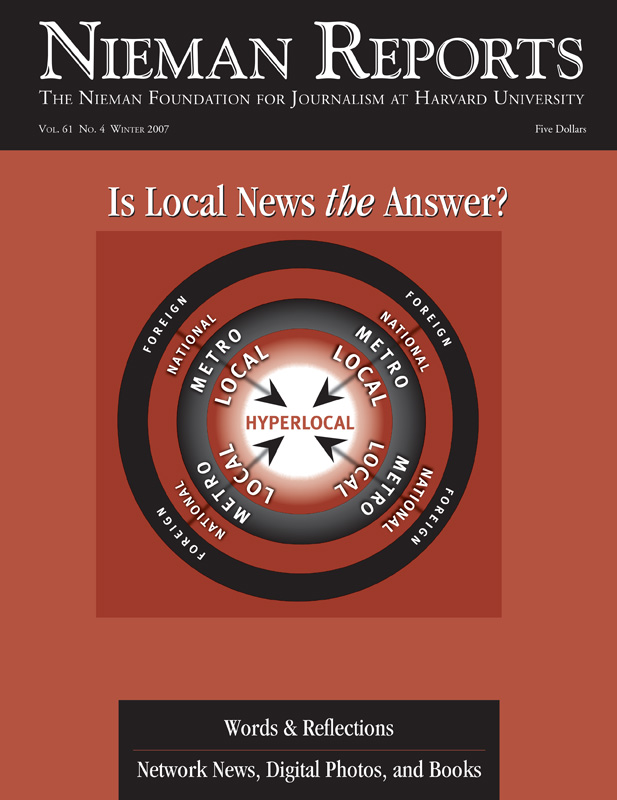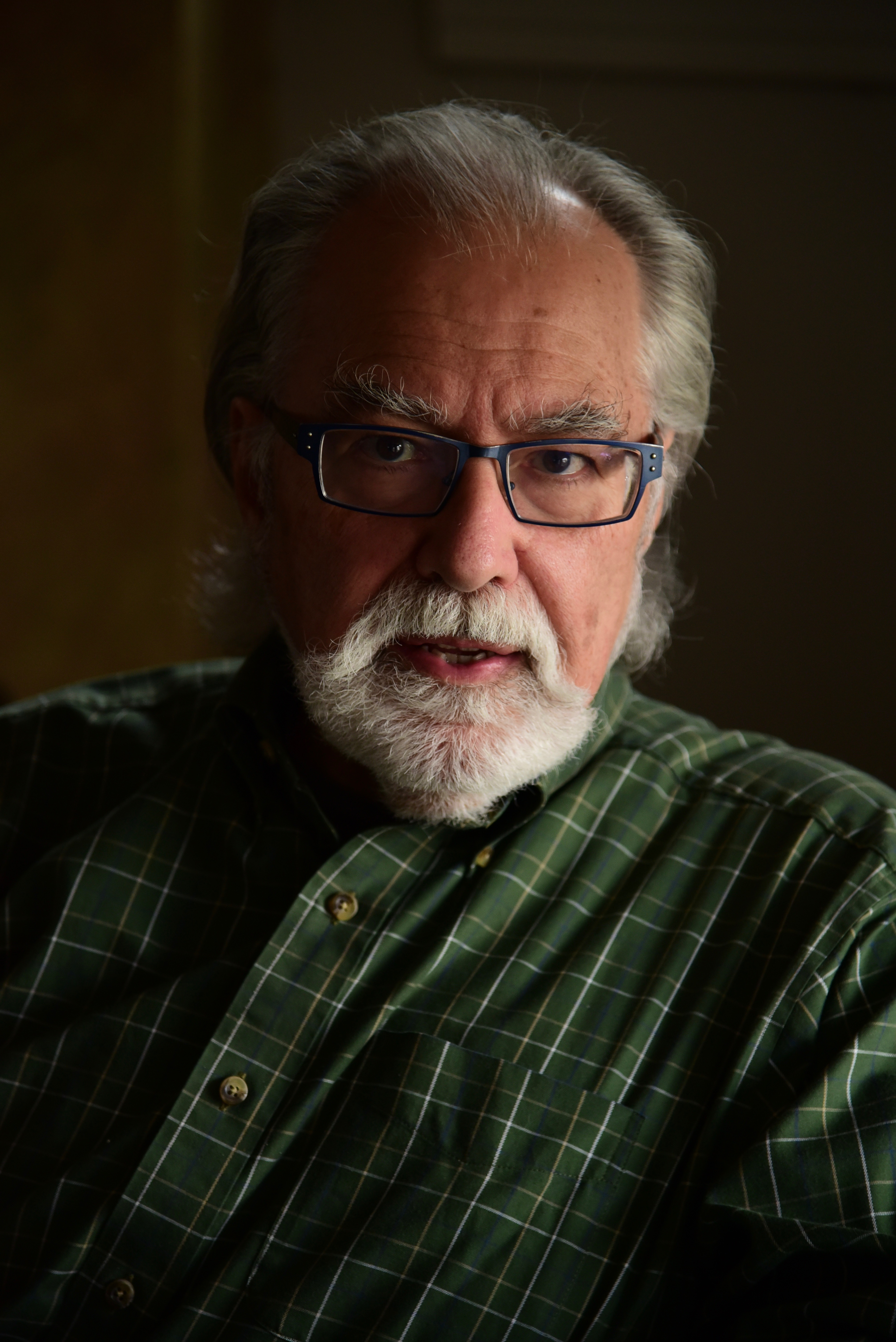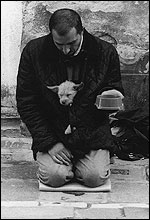It says something that for at least six years Gianni Berengo Gardin, one of Italy’s—and the world’s—finest photojournalists and documentary photographers, has found it necessary to stamp these words on the back of his images, along with his copyright notice: “Vera Fotografia—non corretta, modificata o inventata al computer.” (The English translation is “True photography—not corrected, modified or created by computer.”)
Ah, for the days when we believed the camera could never lie. Credit digital with calling into question almost everything we hold dear about the camera’s ability to document the world around us accurately and dispassionately.
I first saw Berengo Gardin’s notice about computer manipulation (or lack thereof) in the front of his small, brick-thick paperback book, “Gli Italiani,” and recall thinking at that moment that surely such a statement was unnecessary for a photographer of his stature. By then, he’d been making brilliant images for more than a half century and was widely regarded on a par with the legendary Henri Cartier-Bresson. Like the late Cartier-Bresson (who stopped photographing seriously decades before his death in 2004), Berengo Gardin, who is still shooting, is known for his gritty black and white images. Similarities continue in that each photographer used available light and shot with tiny Leicas, with the resulting images published in absolute full-frame. Berengo Gardin’s work routinely captures what Cartier-Bresson famously called “the decisive moment” when all elements of composition, gesture and light combine to make a perfect, or near-perfect, photograph.
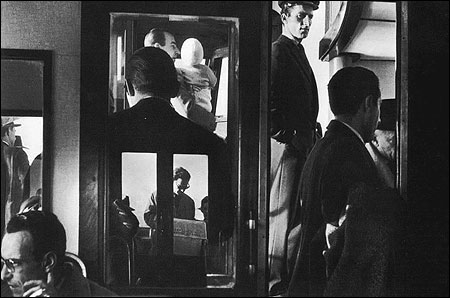
This remarkable photograph by Berengo Gardin defines “the decisive moment” as well as, or better than, any by Cartier-Bresson. Taken on a Venetian waterbus decades ago, this photo juxtaposes myriad figures beautifully—even creating a bit of surrealism in the figure reflected in the glass. Created in a fraction of a second, the image is brilliant; if made in Photoshop, it would merely be a parlor trick. Photo courtesy of © Gianni Berengo Gardin.
But then it hit me: If a photographic giant like Berengo Gardin feels it necessary to distance himself and his work from the morass that can be digital manipulation, surely those of us of lesser reputation and renown run an even greater risk of having our work downgraded, denigrated—even doubted—in the brave new world of digital.
This danger extends far beyond the work of individual photographers. I fear that all of photojournalism is at risk of having its work cast aside as mere illustration—a passable representation of an event, like the engraved drawings of battlefield artists in the years before half-tone printing made possible the mass publication of actual photographs—and not necessarily a “true” depiction of what is real or what actually happened.
Digital Transformation
Far-fetched? I wish it were so. But think back just to the recent past and recall when news publications and news agencies were burned by fabricated images. Wire service photos of bombings in Baghdad in which smoke from one explosion was put through Photoshop and transformed into two or three explosions to enhance its dramatic impact. In another situation, two good war shots were combined into one great one before the photographer’s digital “handiwork” was discovered—which cost Brian Walski, a photographer with the Los Angeles Times, his job.
On a more mundane, but no less egregious, level for its dishonesty, Allan Detrich, former photographer for the Toledo Blade, routinely added or subtracted elements from his news photos during the course of at least one year; this included a dramatic shot of a female basketball player jumping for a ball that Detrich conveniently had inserted into the frame from God knows where. (Happily, this photo was not printed. It was discovered this year, however—complete with bogus basketball—among those he had submitted to his editors for publication.)
Surely, these are isolated incidents, and the vast majority of news photographers would never resort to such visual dishonesty. Or at least I hope not. But in light of the Walski case, I also must pay reluctant attention to what some have called “the cockroach theory of journalism.” It goes like this: Turn on the kitchen light at night and, if you see one cockroach, you can bet there are dozens—maybe even hundreds—more nearby, but unseen. In journalism, it means that when the public sees one news photographer manipulating images as Walski did, the assumption inevitably will be that this dishonest shooter is simply one of many. And that, in turn, blackens the reputation of everyone in the news business.
In discussing the Walski episode, Pete Souza of the White House News Photographer’s Association, of which I am a member, made no attempt to defend Walski’s action; he merely expanded its context, and in so doing made an important point about another situation that subtly, though significantly, impacts photojournalism today.
Souza noted that in the case of newspapers especially—but also among news magazines and news agencies—economic pressures are forcing news outlets to rely ever more heavily on unvetted freelancers, or stringers, for images, especially in war zones or other places where it would be too dangerous or, more likely, too expensive to station a regular photo correspondent. Taking nothing away from most stringer’s honesty or courage, there is nothing like the bond that exists between a staffer and his or her picture desk (stormy though that relationship may be at times) and the unstated though universally accepted belief that news photos must never be manipulated to alter their essential truth.
Could the dog’s head have been added later in Photoshop? Sure, but the fact that it wasn’t adds to the inherent value of this photo—as journalism and as a work of art. Photo courtesy of © Judith Goodman.
View larger image »This is one reason that my wife and I, following the lead of Berengo Gardin, plan to add this notice at the front of our forthcoming book about Venice in winter: “None of the photographs in this book was manipulated digitally to add or remove compositional elements or to alter the truth of the image.”
To be sure, virtually all major news organizations today expressly forbid computer enhancement or manipulation of news photos, beyond the kind of tweaking and cropping that previously had been done in the darkroom. This latter kind of alteration most often was done to remove extraneous elements from the edges of a news shot or to improve the brightness and/or contrast of an image for reproduction. But given the sad state of photojournalism today—and the ease with which images can be put through Photoshop and transformed into things they never were—it now might be necessary for news outlets to specifically label their news photos as real.
Labeling Images
Suppose, for example, the term “Photo Vero,” (or even “PV” once the term was widely known) was used in each news photo’s caption or credit line to certify that the attendant image has not been digitally manipulated beyond darkroom-like changes to enhance reproduction. In other words, what viewers see is a “true photograph,” not a photographic illustration in which an errant telephone wire has been airbrushed out, or an extraneous person or thing has been put in the background through Photoshop, or something has been added (for your benefit, of course) to better tell the story. (Such stiff-necked rules would not apply to deliberately done photo-illustrations that accompany news or feature stories. Yet it is common practice for news organizations to so label such composite images, lest they be confused with the real thing. My suggestion merely takes this one step further.)
Granted, incorporating “Photo Vero” into every caption is like asking every journalist to affirm that he or she is honest and true. (Who, after all, is going to say otherwise—at least in print?) But my hope is that the practice might crank up the pressure on those who think that just a little photo manipulation can’t really hurt. Who’s gonna miss that telephone pole, anyway?
Finally, there is the simple fact that those of us who love being photographers by definition love the act of “writing with light,” which is what the word “photography” literally means. We do not necessarily love “writing with pixels” or “writing with Photoshop” or writing with whatever new electronic toy comes down the pike.
There will certainly be those who will satisfy their artistic and creative selves by manufacturing wonderful images on the computer. These folks might be extraordinary photo-illustrators or photo-manipulators, but they definitely are not photojournalists, nor are they documentarians, and they should not be confused with them.
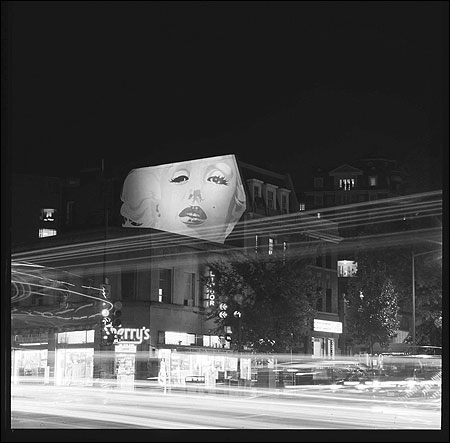
Artist John Bailey’s iconic mural of Marilyn Monroe graces the intersection of Connecticut Avenue and Calvert Street in Washington, D.C.. I wanted to interpret the scene at dusk and at night and show the activity of the bustling intersection (This photo at left is the one I took at night.) Each exposure was more than a minute—evidenced by the fact that all the traffic signals are aglow at once. Photo courtesy of © Frank Van Riper.
I know how much I loved being able to create two of my favorite color images of a famous mural in Washington, D.C.—John Bailey’s giant iconic image of Marilyn Monroe—totally in my camera, requiring no post-production work at all. It took a lot of planning—thinking how to make the light trails of cars and buses work in both images—and at least one site visit and a lot of sitting on a ladder with my tripod-mounted Hasselblad as I waited for my version of two decisive moments to occur as day turned into night.
The result was worth the work I put into doing it, and I didn’t have to go blind in front of a computer screen amid layers, cutouts and tools for sharpening images. When what I saw through my lens was captured within my camera, my job was done.
Frank Van Riper, a 1979 Nieman Fellow, is a documentary and fine art photographer, journalist and author. This article is adapted from a column published on his Web site, www.washingtonpost.com/wp-srv/photo/essays/vanRiper/. Since 1992, Van Riper has been a Washington Post columnist with “Talking Photography.” His book of the same name, a 10-year collection of his columns and other writing, was published in 2001. “Serenissima: Venice in Winter,” coauthored with his wife, photographer Judith Goodman, will be published next year.


